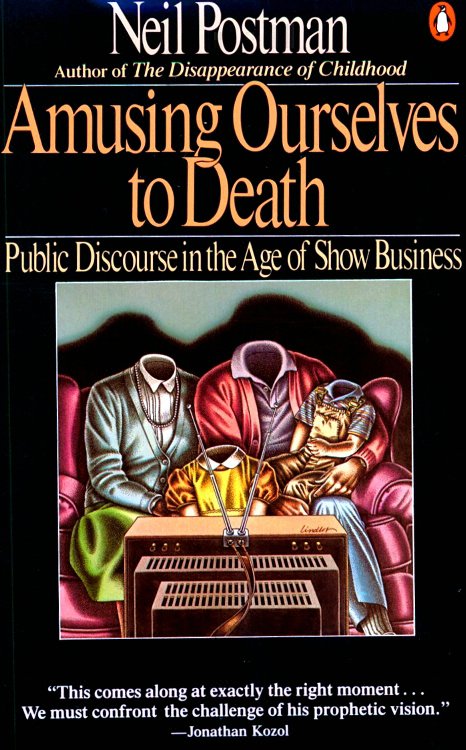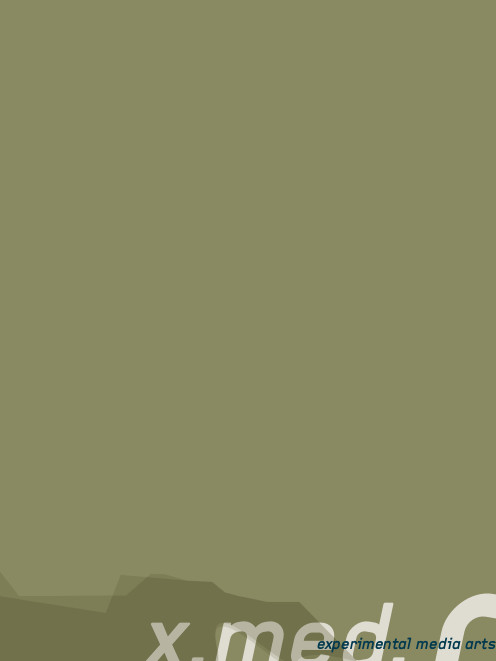Neil Postman: Amusing Ourselves to Death: Public Discourse in the Age of Show Business (1985)
Filed under book | Tags: · culture, entertainment, mass media, media ecology, show business, social criticism, sociology, television

The book originated with Postman’s delivering a talk to the Frankfurt Book Fair in 1984. He was participating in a panel on Orwell’s 1984 and the contemporary world. In the introduction to his book Postman said that reality was reflected more by Aldous Huxley’s Brave New World where the public was oppressed by pleasure than Orwell’s 1984 where they were oppressed by pain.
Television has conditioned us to tolerate visually entertaining material measured out in spoonfuls of time, to the detriment of rational public discourse and reasoned public affairs. Neil Postman alerts us to the real and present dangers of this state of affairs, and offers compelling suggestions as to how to withstand the media onslaught. Before we hand over politics, education, religion, and journalism to the show business demands of the television age, we must recognize the ways in which the media shape our lives and the ways we can, in turn, shape them to serve out highest goals.
Publisher Penguin Books, 1985
ISBN 0140094385, 9780140094381
Length 184 pages
More info (wikipedia)
More info (publisher)
More info (google books)
Matthew Fuller: Media Ecologies: Materialist Energies in Art and Technoculture (2005)
Filed under book | Tags: · art, cctv, hylomorphism, media ecology, memetics, network culture, new media, philosophy, pirate radio, surveillance, technology

In Media Ecologies, Matthew Fuller asks what happens when media systems interact. Complex objects such as media systems—understood here as processes, or elements in a composition as much as “things”—have become informational as much as physical, but without losing any of their fundamental materiality. Fuller looks at this multiplicitous materiality—how it can be sensed, made use of, and how it makes other possibilities tangible. He investigates the ways the different qualities in media systems can be said to mix and interrelate, and, as he writes, “to produce patterns, dangers, and potentials.”
Fuller draws on texts by Felix Guattari and Gilles Deleuze as well as writings by Friedrich Nietzsche, Marshall McLuhan, Donna Haraway, Friedrich Kittler, and others, to define and extend the idea of “media ecology.” Arguing that the only way to find out about what happens when media systems interact is to carry out such interactions, Fuller traces a series of media ecologies—”taking every path in a labyrinth simultaneously,” as he describes one chapter. He looks at contemporary London-based pirate radio and its interweaving of high- and low-tech media systems; the “medial will to power” illustrated by “the camera that ate itself”; how, as seen in a range of compelling interpretations of new media works, the capacities and behaviors of media objects are affected when they are in “abnormal” relationships with other objects; and each step in a sequence of Web pages, Cctv—world wide watch, that encourages viewers to report crimes seen via webcams.
Contributing to debates around standardization, cultural evolution, cybernetic culture, and surveillance, and inventing a politically challenging aesthetic that links them, Media Ecologies, with its various narrative speeds, scales, frames of references, and voices, does not offer the academically traditional unifying framework; rather, Fuller says, it proposes to capture “an explosion of activity and ideas to which it hopes to add an echo.”
Published by MIT Press, 2005
ISBN 026206247X, 9780262062473
265 pages
PDF (updated on 2012-7-15)
Comment (0)X-MED-A: Experimental Media Arts (2006)
Filed under book | Tags: · art, code, experimental art, generativity, media art, media ecology, music, performance, software, sound art, sound recording, technology, textile, video, workshop

“In X-MED-A publication you can find more than 40 contributions from a motley crew of artists, designers and engineers, including Matthew Fuller, Joey Berzowska, Casey Reas, Akihiro Kubota along with many other clever and lovely people. The articles, interviews, poems and patches reflect upon education and play, poetics and aesthetics, technology and collaboration, politics and economics of experimental media arts, steeped in a sea of photographs, diagrams, screenshots and illustrations.
The review originated from a series of technically and artistically diverse workshops, organised by four independent technological arts initiatives in Brussels: FoAM, nadine, okno and iMAL. The workshops responded to the needfor a place where continuous learning and dialogue between peers is encouraged, with the objective of sharing of experience, skills and knowledge among diverse groups interested in emerging ideas, media and technologies.”
Contributions by mxhz.org, Guy van Belle, Angez Bewer, Bartaku, Johanna Berzowska, Nicolas Collins, Alejandra Perez Nunez, Akihiro Kubota, Franziska Huebler, Carole Collet, FoAM, Eleonora Oreggia, Casey Reas and Ben Fry, jasch, David Griffiths, Toplap, so-on, Xavier Ess, Els Viaene and Dieter van Dam, Code31, Nadine, Yves Bernard, HC Gilje, Rachel Wingfield, Christoph de Boeck, Isjtar, Nicolas d’Alessandro, Jelle Dierickx, Jenny Tillotson, Jessica Hemmings, Toysband, Alejo Duque, Erik Parys, Pablo Diartinez
With an introduction by Matthew Fuller
Edited by Maja Kuzmanovic (FoAM), nadine, Annemie Maes (okno), Yves Bernard (iMAL)
Assistant editor: Alkan Chipperfield
Publisher: FoAM, nadine, okno, and iMAL, Brussels, 2006
Creative Commons Attribution-NoDerivs 2.5 License
ISBN 908107332X
156 pages
Project website
Editor (FoAM)
PDF (updated on 2021-12-29)
Comment (0)
